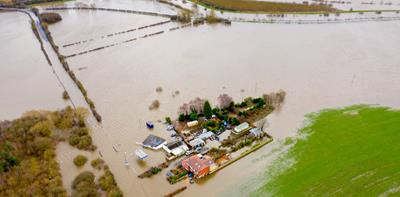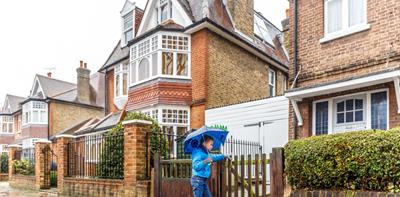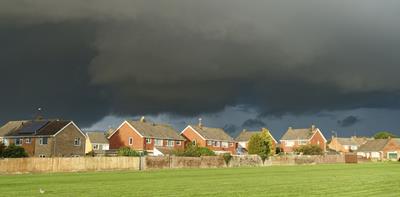
The UK’s weather is famously unpredictable – but one thing you can be sure of is that each year it will unleash tough conditions that will flood homes, topple trees and cause expensive damage.
Prevention is better than cure, so it’s always worth taking steps to lessen potential damage caused by adverse weather conditions.
Here are some steps you can take to help protect your home.
Please note that some of the maintenance suggested here could be potentially hazardous, such as using a ladder or cutting down branches. If there’s anything you’re not confident with, it’s always best to contact a professional.
Drainage and gutter maintenance
Making sure your gutters and drainage are in tip-top condition is among the most important household maintenance tasks. If gutters aren’t draining properly, it can cause damage to your roof and walls. It could also result in water damage inside the house.
That’s why you should clear debris from gutters and downspouts regularly, ensuring unobstructed water flow. You could consider installing gutter guards, which minimise the accumulation of leaves and debris.
Find out more about how to protect your gutters here.
Check your roof
The roof is one of the most vulnerable areas of a home when it comes to weather damage. It’s a good idea to inspect it regularly, and fix any issues immediately after you identify them.
Check for:
- Loose, cracked or missing tiles
- Damaged flashing, which is the thin metal used to keep your roof watertight
- Any signs of leakage
You can also check the roof from the inside, particularly if you have an attic. Head up there and look for any signs of water getting in, such as damp areas or mould. If you don’t have an attic, check for damp patches or discolouration on your ceiling.
Generally speaking, flat roofs need more maintenance than pitched roofs, and tend to need more frequent repairs[1]. Try to inspect your flat roof at least twice a year, and after each storm. Be sure to clear any leaves or debris which might hamper the drainage.
If you find any issues with your roof, it’s usually best to get a professional roofer or builder in to fix it. Never take any chances if you’re not entirely confident fixing it yourself.
[1] https://www.ricsfirms.com/residential/moving-home/buying/flat-roofs-pros-cons/
Exterior walls, windows and doors
Your exterior walls, windows and doors should also be weatherproofed as best as possible. Inspect walls for cracks, loose mortar or signs of dampness. Be sure to seal any gaps or holes you find to prevent water penetration.
If you find damp or mould on the inside of your exterior walls, this should also be addressed as soon as possible – not least because it can be a health risk. Find out more about tackling damp and mould here.
Check windows and doors for damaged seals, or frame damage – anything which might let in draughts or water. You could consider installing weatherstripping for added protection.
Close doors and windows
It might sound obvious, but ahead of any bad weather, you should make sure all windows, doors and skylights are shut tight, and ideally fastened. This will stop rain getting in, draughts and the potential for them blowing open.
Ensuring everything’s sealed tight will also prevent any pets trying to escape if they become panicked.
If you have a hailstorm, it’s a good idea to close curtains and blinds. This is because, if a window smashes, it’ll act as a barrier against broken glass.
Also, if you’re a keen gardener, you can protect plants and flowers with netting, or upturned items such as baskets or pots.
Protect your belongings
If there’s a risk of water getting into the house, it may be best to move items you don’t want to get damaged out of harm’s way. If your house has more than one storey, move valuable items upstairs, keeping them clear of windows which might blow open.
Otherwise, if there’s a risk of surface flooding, keep anything important elevated. Unplug electrical items from sockets close to the floor. It’s a good idea to shut off the electricity entirely if your home looks like it may flood.
If you have enough warning, it may be worth investing in flood protection to prevent water getting in, such as plastic sheeting for air vents, and covers that fit over air bricks to stop flood water from entering.
Find out more about flood risk here.
Plumbing and pipe protection
Frozen pipes and water damage are common issues during cold spells. It’s always best to insulate exposed pipes in unheated areas, such as basements and attics.
You should also inspect pipes for leaks, corrosion or signs of damage. If you discover any issues, get them promptly repaired to prevent further damage.
Find out more about preventing frozen and burst pipes here.
If the temperatures are likely to fall below freezing, keep the heating system on a low setting or use a thermostat-controlled frost protection system when temperatures drop.
Find out whether it’s best to keep your heating on low, or used timed bursts.
Garden and tree maintenance
If you have a garden, you can brace this too in order to prevent weather damage. In particular, make sure you trim trees and remove loose branches. This should reduce the risk of them falling or blowing into your property during storms.
It’s also a good idea to regularly prune shrubs and plants away from the exterior walls, as this prevents moisture accumulation.
Garden furniture, equipment and ornaments should also be secured or protected ahead of bad weather. If possible, store any loose items away in a shed or outbuilding. Otherwise, you could weigh furniture down, or bring it inside. Don’t forget rubbish bins or recycling crates.
Protect your fences
Fences can be particularly vulnerable to strong winds, so take time to ensure they’re secure. If not, it’s best to get them fixed. If you’re short on time, any loose wood you have and a couple of nails should be a quick fix until the bad weather passes.
For more information about how to protect your home and belongings, go to Solved.
You can find out more about our home insurance here.


